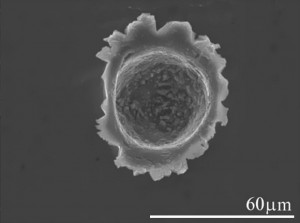The trouble with impacts is that they tend to mess everything up, from the projectile to the target to the target chamber in the gun lab when I am investigating ice and water impacts. However, there is one case where the collection of material through impacts may have skewed the expected results from an investigation into the composition of a cometary nucleus to the changes in mineral composition as a result of impact shock.
The Stardust mission was a landmark for planetary sciences as it provided the first material to be collected and recovered from a comet.

Artist impression of Stardust Space crater http://stardust.jpl.nasa.gov/photo/artist.html
The spacecraft flew into the tail of comet Wild2 and collected material within the tail within aerogel, a synthetic porous silica gel where the liquid is replaced by gas making the material 98.2% air. This material captured the material within the tail of the comet and then travelled back to Earth.
The material from the comet was travelling at around 6.2 km/s when impacting the aerogel, and a lot of material also impacted the Al foil that lay on the grid securing the aerogel capture system.
Once the Spacecraft was back on Earth the material within the aerogel and foil craters were analysed to discover the composition of the nucleus of a comet.
However, one question that sat in the minds of people who investigate impacts such as myself was, how has the impact effects the composition of the material currently being analysed?
This is a rather big problem, shock from impacts is known to causing melting, devolitisation, and changes to the structure and event composition. Therefore is the composition of the material collected by stardust pristine or modified as a result of the impact. If modified then the science community is not investigating the composition of the comet but the results of shock-altered material.
What had to be done is experimentation within laboratory environments to understand the changes that had occurred to the Stardust material and to formulate the right corrections to make on the analysis results so that the composition of the comet can be determined.
This was undertaken by Foster et al, 2013 and Harriss et al, 2016. They took the material of known composition, Olivine, and fired it using the light gas gun at the University of Kent at the Aerogel and Al foils used on the Stardust mission at the same speed at the material is thought to have impacted the spacecraft collector ~6 km/s.
What was found was that when analysing the crater residue using RAMAN techniques the position of the Peaks of the unshot olivine grains did not match those of the olivine residues within the crater formed at a speed of ~6 km/s. This meant that the analyses by RAMAN of the Stardust grains would have produced incorrect compositional results and that a correction would be required.
This work only shows a correction is required for RAMAN analysis and has to this point only investigated the effects of olivine minerals. The next step would be to repeat these investigations using other minerals that have been located within the collected comet material including Enstatite.

